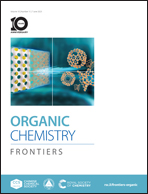DFT study on stereoselective Rh-catalyzed intramolecular [2 + 2 + 2] cycloaddition of allene–ene–ynes†
Abstract
Density functional theory has been employed to investigate the mechanisms of Rh-catalyzed intramolecular [2 + 2 + 2] cycloaddition reactions. The reaction starts with the coordination of a Rh center in the catalyst to the alkyne in reactant 1a firstly, and then to one of the double bonds in the allene, leading to the formation of the first six-membered ring. After that, there are two different reaction pathways, which result in the [2 + 2 + 2] and [2 + 2] products, respectively. For the [2 + 2 + 2] reaction pathway, the remaining alkene in reactant 1a will coordinate to the Rh center, and then there are two successive C–C couplings to make the second six-membered ring and one three-membered ring, which leads to the formation of the final product. At the same time, the broken Rh–Cl bond will be formed again to finish the recovery of the catalyst and the separation of the final product. It was deduced from the energy span model that the TOF-determining transition state (TDTS) and intermediate (TDI) are TS3 and INT2, and thus the activation free-energy barrier is 32.1 kcal mol−1 at the temperature of 383.75 K. The substituent effect and intermolecular interaction energy have also been addressed in this paper.
![Graphical abstract: DFT study on stereoselective Rh-catalyzed intramolecular [2 + 2 + 2] cycloaddition of allene–ene–ynes](/en/Image/Get?imageInfo.ImageType=GA&imageInfo.ImageIdentifier.ManuscriptID=D3QO00363A&imageInfo.ImageIdentifier.Year=2023)
- This article is part of the themed collection: 2023 Organic Chemistry Frontiers HOT articles


 Please wait while we load your content...
Please wait while we load your content...